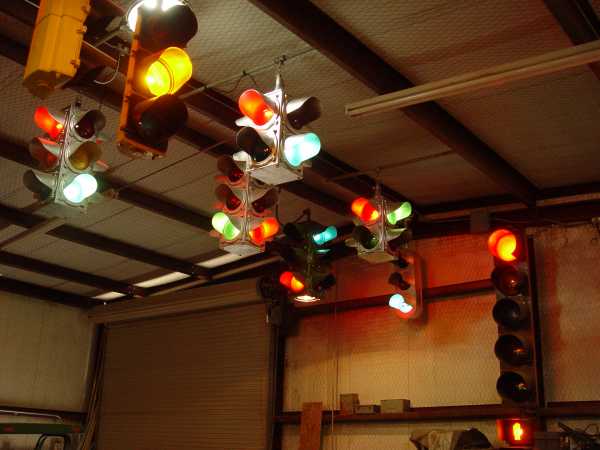For you enthusiasts who wish to learn more about traffic signal systems and terms, here are some traffic signal and traffic management terms from the HVCEO
Traffic Coordination Handbook.
- Actuated Operation Type of traffic signal control operation in which some or all signal phases are actuated from vehicle detectors.
- Concurrent Pedestrian Phase A signal phase where pedestrians may cross parallel with the vehicles that have a green signal.
- Controller An electrical device mounted in a cabinet for controlling the operation of a traffic signal.
- Crosswalk Any portion of a roadway distinctly designated for pedestrian crossing by lines or other markings on the surface.
- Cycle Length The time required to complete a full sequence of traffic movements.
- Detector A sensing device (usually either embedded in the pavement or from video camera locations) used for determining the presence or passage of vehicles or pedestrians. Detectors are used in an actuated or semi-actuated operation.
- Exclusive Pedestrian Phase A signal phase where vehicular traffic is stopped in all directions and pedestrians are allowed to cross in all directions.
- Functional classification Grouping of highways based on the character of service they provide. Freeways, arterials, collectors, and local roads fall under different functional classifications.
- Green Band The amount of green time available to a group of vehicles in a progressive signal system.
- Interval A portion of a signal cycle where signal indications do not change.
- Offset The time duration between the initiation of the progressed movement (phase) common to any two signals at the two intersections. It is generally measured at the downstream intersection relative to the upstream intersection.
- Patterns of Operation A set of cycle lengths, splits, and offsets part of a signal coordination plan.
- Permissive Mode A mode of traffic control signal operation in which, when a green light is displayed, left or right turns may be made after yielding to oncoming traffic and/or pedestrians.
- Phase Sequence The order of appearance of signal phases during a signal cycle.
- Platoon A group of vehicles traveling together as a group, because of traffic control signals, roadway geometry, and other factors.
- Pre-emption Control A change in traffic signal operation from normal to a special mode. This type of control is most commonly used for emergency vehicles such as fire, ambulance, and police to give them priority in an emergency.
- Pre-timed Operation Type of signal control operation where a signal cycle follows a fixed sequence, the intervals of which are of fixed length.
- Progression A time relationship between adjacent signals permitting continuous operations of groups of vehicles at a planned rate of speed.
- Protected Mode A mode of traffic signal operation in which left or right turns are protected from oncoming vehicular traffic. Under this operation, a GREEN ARROW is displayed and opposing traffic must stop.
- Red Interval A very short period in a signal phase where traffic is stopped in all directions and all signals display a RED BALL or RED ARROW.
- Semi-actuated Operation A type of traffic control signal in which at least one, but not all, signal phases function on the basis of actuation.
- Signal Coordination The establishment of timed relationships between adjacent traffic control signals.
- Signal Phase The portion of a signal cycle that serves a combination of traffic movements.
- Signal System Two or more traffic control signals operating in signal coordination.
- Signal Timing The amount of time allocated for the display of a signal indication.
- Split A portion of the cycle length allocated to each phase that may occur.
- Time-Space Diagram A two-dimensional representation of the spacing of various signals along a roadway and the signal indications of each of these signals as a function of time.
- Walk Time The time provided for a pedestrian, crossing in a crosswalk, to safely cross the roadway. A WALK and DONT WALK signal is displayed to direct pedestrians to cross the roadway.
- Yellow Interval This interval follows the green interval and is a warning for motorists to slow down before the red interval is displayed.
|

